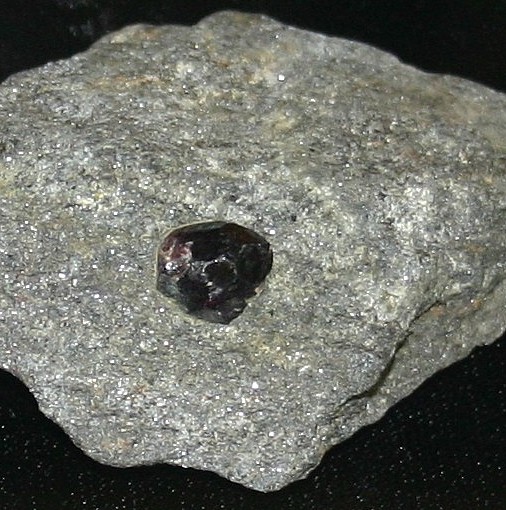|
.
Pyrope
Mineral Facts:
Chemical
Formula: Mg3Al2(SiO4)3
Magnesium
aluminium silicate
- An orthosilicate which conforms to a general
garnet formula.
Colors:
Deep red to
purple, sometimes nearly black.
Hardness:
7
Density:
3.7
Cleavage:
None.
Crystallography: Isometric, hexoctahedral
Pyrope is rarely well
crystallized ; usually in rounded or
angular fragments. When crystalized, commonly forms dodecahedron and
trapezohedron, often in combination. Hexoctahedron observed at times.
Luster:.
Vitreous ; transparent to translucent..
Optics: (Refractive Index): = 1.7412 to 1.7504
Composition, Structure and
Associated Minerals:
Pyrope occurs in basic igneous rocks associated with olivine, serpentine,
basalt, etc., as in Arizona or at Saxony, Bohemia; also in detrital
deposits, as in Sri Lanka. Pyrope is a Magnesium aluminium garnet, but is
rarely pure and often contains a portion of Calcium and iron. If perfectly
pure, pyrope would be colorless. It is often transparent and then used as a
gem. The name is derived from the Greek, meaning fire like. Rhodolite
is name
given to a pale rose-red or purple garnet, corresponding in composition to
two parts of pyrope and one of almandite.
Identification
and Diagnostics
Fusible within the blowpipe
flame. Garnets, when in crystals, are easily distinguished
from other similarly crystallizing substances by their characteristic
isometric crystals, color and hardness, etc. Massive garnet may resemble vesuvianite,
sphene, zircon or
tourmaline. It is distinguished from
zircon by its easier fusibility and from vesuvianite by its more difficult
fusibility; from tourmaline by its higher specific gravity, and from sphene
by the reaction from titanium.
It frequently requires a chemical
analysis to positively distinguish between the different members of the
group, or the percentages of each molecule in an individual specimen.
|

Pyrope Garnet |
|
Occurrence,
Localities and Origins:
The Many pyrope garnets are transparent, so the principal use is as a
gemstone. Those with a dark red color can be cut as very small gems and
still show good color because of the color intensity of these garnets.
This gem was extremely popular in Victorian times, late in the 1800s, and
even into the early 1900s. The stones were inexpensive and came from mines
located near Teplitz and Bilin,
in
what is now the Czech Republic.
This became a very famous localities
for pyrope gems and millions of pounds of gems were mined over hundreds of
years time.
Other
sources of pyrope are Santa Fe in New Mexico.
The principal occurrence of
Pyrope garnet of gem quality
in this country is in
northeastern
Arizona, near the Utah state line, about 100 miles west of Ganado, Arizona.
It is found associated with clear grains
of
peridot in the surface sands
and gravels
where it is found lying loose
along the course of the San Juan river, and is known locally as the "Arizona
ruby."
Pyrope
is also obtained in South Africa, where it occurs associated with diamond in
kimberlite, and is there known as the "Cape ruby." Because of pyrope's
durability, it is found in detritus and alluvial sands. Because it is also
associated with basic rocks like kimberlite that also host diamonds, it has
been used as an exploration tool for those seeking diamond deposits.
Pyrope garnets of a certain chemical make up can indicate diamond deposits
may be located nearby.
Rhodolite is a pale-red variety of mixed molecule garnet with a violet
tinge. It is intermediate in composition between pyrope and almandine, its
composition corresponding to a mixture of these two varieties in the
proportion of two molecules of pyrope to one of almandine. It has a
brilliant lustre, and a specific gravity 3-84. It occurs in an altered basic
igneous rock associated with ruby in Macon County, North
Carolina, U.S.A., and is found also in a decomposed micaceous band in a
gneiss rock at Dewalegama in Sri Lanka. Rhodoliet has also been mined in
Tanzania in east Africa.
.Return
to the
Mineral Collectors Information Page |
|


